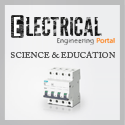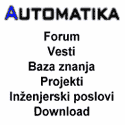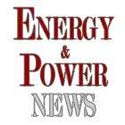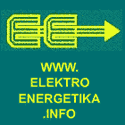38,290 views
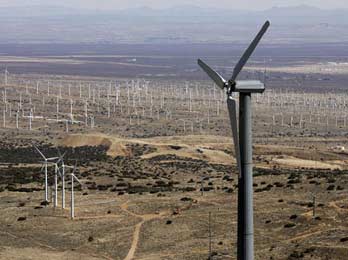
Wind Power Applications
The wind is a free, clean, and inexhaustible energy source. It has served humankind well for many centuries by propelling ships and driving wind turbines to grind grain and pump water. Denmark was the first country to use wind for generation of electricity. The Danes were using a 23-m diameter wind turbine in 1890 to generate electricity. By 1910, several hundred units with capacities of 5 to 25 kW were in operation in Denmark (Johnson, 1985). By about 1925, commercial wind-electric plants using two- and three-bladed propellers appeared on the American market. The most common brands were Win- charger (200 to 1200 W) and Jacobs (1.5 to 3 kW). These were used on farms to charge storage batteries which were then used to operate radios, lights, and small appliances with voltage ratings of 12, 32, or 110 volts. A good selection of 32-VDC appliances was developed by the industry to meet this demand.
In addition to home wind-electric generation, a number of utilities around the world have built larger wind turbines to supply power to their customers. The largest wind turbine built before the late 1970s was a 1250-kW machine built on Grandpa’s Knob, near Rutland, Vermont, in 1941. This turbine, called the Smith-Putnam machine, had a tower that was 34 m high and a rotor 53 m in diameter. The rotor turned an ac synchronous generator that produced 1250 kW of electrical power at wind speeds above 13 m/s.
After World War II, we entered the era of cheap oil imported from the Middle East. Interest in wind energy died and companies making small turbines folded. The oil embargo of 1973 served as a wakeup call, and oil-importing nations around the world started looking at wind again. The two most important countries in wind power development since then have been the U.S. and Denmark (Brower et al., 1993).
The U.S. immediately started to develop utility-scale turbines. It was understood that large turbines had the potential for producing cheaper electricity than smaller turbines, so that was a reasonable decision. The strategy of getting large turbines in place was poorly chosen, however. The Department of Energy decided that only large aerospace companies had the manufacturing and engineering capability to build utility-scale turbines. This meant that small companies with good ideas would not have the revenue stream necessary for survival. The problem with the aerospace firms was that they had no desire to manufacture utility-scale wind turbines. They gladly took the government’s money to build test turbines, but when the money ran out, they were looking for other research projects. The government funded a number of test turbines, from the 100 kW MOD-0 to the 2500 kW MOD-2. These ran for brief periods of time, a few years at most. Once it was obvious that a particular design would never be cost competitive, the turbine was quickly salvaged.
Denmark, on the other hand, established a plan whereby a landowner could buy a turbine and sell the electricity to the local utility at a price where there was at least some hope of making money. The early turbines were larger than what a farmer would need for himself, but not what we would consider utility scale. This provided a revenue stream for small companies. They could try new ideas and learn from their mistakes. Many people jumped into this new market. In 1986, there were 25 wind turbine manufacturers in Denmark. The Danish market gave them a base from which they could also sell to other countries. It was said that Denmark led the world in exports of two products: wind turbines and butter cookies! There has been consolidation in the Danish industry since 1986, but some of the com- panies have grown large. Vestas, for example, has more installed wind turbine capacity worldwide than any other manufacturer.
Prices have dropped substantially since 1973, as performance has improved. It is now commonplace for wind power plants (collections of utility-scale turbines) to be able to sell electricity for under four cents per kilowatt hour.
Total installed worldwide capacity at the start of 1999 was almost 10,000 MW, according to the trade magazine Wind Power Monthly (1999). The countries with installed capacity until end of 2009 are shown in Table 1.
| # | Nation | 2005 | 2006 | 2007 | 2008 | 2009 |
|---|---|---|---|---|---|---|
| - | European Union | 40,722 | 48,122 | 56,614 | 65,255 | 74,767 |
| 1 | United States | 9,149 | 11,603 | 16,819 | 25,170 | 35,159 |
| 2 | Germany | 18,428 | 20,622 | 22,247 | 23,903 | 25,777 |
| 3 | China | 1,266 | 2,599 | 5,912 | 12,210 | 25,104 |
| 4 | Spain | 10,028 | 11,630 | 15,145 | 16,740 | 19,149 |
| 5 | India | 4,430 | 6,270 | 7,850 | 9,587 | 10,925 |
| 6 | Italy | 1,718 | 2,123 | 2,726 | 3,537 | 4,850 |
| 7 | France | 779 | 1,589 | 2,477 | 3,426 | 4,410 |
| 8 | United Kingdom | 1,353 | 1,963 | 2,389 | 3,288 | 4,070 |
| 9 | Portugal | 1,022 | 1,716 | 2,130 | 2,862 | 3,535 |
| 10 | Denmark | 3,132 | 3,140 | 3,129 | 3,164 | 3,465 |
| 11 | Canada | 683 | 1,460 | 1,846 | 2,369 | 3,319 |
| 12 | Netherlands | 1,236 | 1,571 | 1,759 | 2,237 | 2,229 |
| 13 | Japan | 1,040 | 1,309 | 1,528 | 1,880 | 2,056 |
| 14 | Australia | 579 | 817 | 817 | 1,494 | 1,712 |
| 15 | Sweden | 509 | 571 | 831 | 1,067 | 1,560 |
Applications
There are perhaps four distinct categories of wind power which should be discussed. These are:
- Small, non-grid connected
- Small, grid connected
- Large, non-grid connected
- Large, grid connected
By small, we mean a size appropriate for an individual to own, up to a few tens of kilowatts. Large refers to utility scale.
.
Small, Non-Grid Connected
If one wants electricity in a location not serviced by a utility, one of the options is a wind turbine, with batteries to level out supply and demand. This might be a vacation home, a remote antenna and transmitter site, or a Third-World village. The costs will be high, on the order of $0.50/kWh, but if the total energy usage is small, this might be acceptable. The alternatives, photovoltaics, microhydro, and diesel generators, are not cheap either, so a careful economic study needs to be done for each situation.
.
Small, Grid Connected
The small, grid connected turbine is usually not economically feasible. The cost of wind-generated elec- tricity is less because the utility is used for storage rather than a battery bank, but is still not competitive. In order for the small, grid connected turbine to have any hope of financial breakeven, the turbine owner needs to get something close to the retail price for the wind-generated electricity. One way this is done is for the owner to have an arrangement with the utility called net metering. With this system, the meter runs backward when the turbine is generating more than the owner is consuming at the moment. The owner pays a monthly charge for the wires to his home, but it is conceivable that the utility will sometimes write a check to the owner at the end of the month, rather than the other way around. The utilities do not like this arrangement. They want to buy at wholesale and sell at retail. They feel it is unfair to be used as a storage system without remuneration. For most of the twentieth century, utilities simply refused to connect the grid to wind turbines.
The utility had the right to generate electricity in a given service territory, and they would not tolerate competition. Then a law was passed that utilities had to hook up wind turbines and pay them the avoided cost for energy. Unless the state mandated net metering, the utility typically required the installation of a second meter, one measuring energy consumption by the home and the other energy production by the turbine. The owner would pay the regular retail rate, and the utility would pay their estimate of avoided cost, usually the fuel cost of some base load generator. The owner might pay $0.08 to $0.15 per kWh, and receive $0.02 per kWh for the wind-generated electricity. This was far from enough to eco- nomically justify a wind turbine, and had the effect of killing the small wind turbine business.
.
Large, Non-Grid Connected
These machines would be installed on islands or in native villages in the far north where it is virtually impossible to connect to a large grid. Such places are typically supplied by diesel generators, and have a substantial cost just for the imported fuel. One or more wind turbines would be installed in parallel with the diesel generators, and act as fuel savers when the wind was blowing.
This concept has been studied carefully and appears to be quite feasible technically. One would expect the market to develop after a few turbines have been shown to work for an extended period in hostile environments. It would be helpful if the diesel maintenance companies would also carry a line of wind turbines so the people in remote locations would not need to teach another group of maintenance people about the realities of life at places far away from the nearest hardware store.
.
Large, Grid Connected
We might ask if the utilities should be forced to buy wind-generated electricity from these small machines at a premium price which reflects their environmental value. Many have argued this over the years. A better question might be whether the small or the large turbines will result in a lower net cost to society. Given that we want the environmental benefits of wind generation, should we get the electricity from the wind with many thousands of individually owned small turbines, or should we use a much smaller number of utility-scale machines?
If we could make the argument that a dollar spent on wind turbines is a dollar not spent on hospitals, schools, and the like, then it follows that wind turbines should be as efficient as possible. Economies of scale and costs of operation and maintenance are such that the small, grid connected turbine will always need to receive substantially more per kilowatt hour than the utility-scale turbines in order to break even. There is obviously a niche market for turbines that are not connected to the grid, but small, grid connected turbines will probably not develop a thriving market. Most of the action will be from the utility-scale machines.
Sizes of these turbines have been increasing rapidly. Turbines with ratings near 1 MW are now common, with prototypes of 2 MW and more being tested. This is still small compared to the needs of a utility, so clusters of turbines are placed together to form wind power plants with total ratings of 10 to 100 MW.
SOURCE: Saifur Rahman Virginia Tech
.
Related articles
3,738 views
Wind power storage development is essential for renewable energy technologies to become economically feasible. There are many different ways in which one can store electrical energy, the following outlines the various media used to store grid-ready energy produced by wind turbines. For more on applications of these wind storage technologies, read Solving the use-it-or-lose-it wind energy problem
Electrochemical Batteries
Familiar electrochemical batteries include nickel-cadmium (NiCad), lithium-ion (Li-ion, and others. Electrochemical batteries consist of two or more electrochemical cells. The cells use chemical reaction(s) to create a flow of electrons – electric current. Primary elements of a cell include the container, two electrodes (anode and cathode), and electrolyte material. The electrolyte is in contact with the electrodes. Current is created by the oxidation-reduction process involving chemical reactions between the cell’s electrolyte and electrodes.
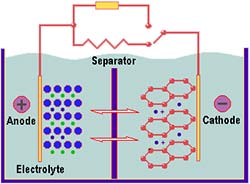
Familiar electrochemical batteries include nickel-cadmium (NiCad), lithium-ion (Li-ion, and others
When a battery discharges through a connected load, electrically charged ions in the electrolyte that are near one of the cell’s electrodes supply electrons (oxidation) while ions near the cell’s other electrode accept electrons (reduction), to complete the process. The process is reversed to charge the battery, which involves ionizing of the electrolyte. An increasing number of chemistries are used for this process.
Flow Batteries
Some electrochemical batteries (e.g., automobile batteries) contain electrolyte in the same container as the cells (where the electrochemical reactions occur). Other battery types – called flow batteries – use electrolyte that is stored in a separate container (e.g., a tank) outside of the battery cell container. Flow battery cells are said to be configured as a ‘stack’. When flow batteries are charging or discharging, the electrolyte is transported (i.e., pumped) between the electrolyte container and the cell stack. Vanadium redox and Zn/Br are two of the more familiar types of flow batteries. A key advantage to flow batteries is that the storage system’s discharge duration can be increased by adding more electrolyte (and, if needed to hold the added electrolyte, additional electrolyte containers). It is also relatively easy to replace a flow battery’s electrolyte when it degrades.
Capacitors
Capacitors store electric energy as an electrostatic charge. An increasing array of larger capacity capacitors have characteristics that make them well-suited for use as energy storage. They store significantly more electric energy than conventional capacitors. They are especially well-suited to being discharged quite rapidly, to deliver a significant amount of energy over a short period of time (i.e., they are attractive for high-power applications that require short or very short discharge durations).
Compressed Air Energy Storage
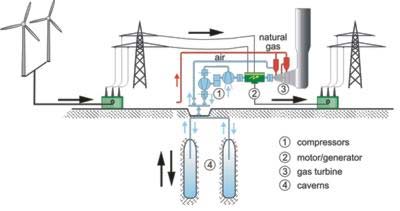
Compressed Air Energy Storage
Compressed air energy storage (CAES) involves compressing air using inexpensive energy so that the compressed air may be used to generate electricity when the energy is worth more.
To convert the stored energy into electric energy, the compressed air is released into a combustion turbine generator system. Typically, as the air is released, it is heated and then sent through the system’s turbine. As the turbine spins, it turns the generator to generate electricity. For larger CAES plants, compressed air is stored in underground geologic formations, such as salt formations, aquifers, and depleted natural gas fields. For smaller CAES plants, compressed air is stored in tanks or large on-site pipes such as those designed for high-pressure natural gas transmission (in most cases, tanks or pipes are above ground).
Flywheel Energy Storage
Flywheel electric energy storage systems (flywheel storage or flywheels) include a cylinder with a shaft that can spin rapidly within a robust enclosure. A magnet levitates the cylinder, thus limiting friction-related losses and wear. The shaft is connected to a motor/generator. Electric energy is converted by the motor/generator to kinetic energy. That kinetic energy is stored by
increasing the flywheel’s rotational speed. The stored (kinetic) energy is converted back to electric energy via the motor/generator, slowing the flywheel’s rotational speed.
Pumped Hydroelectric
Key elements of a pumped hydroelectric (pumped hydro) system include turbine/generator equipment, a waterway, an upper reservoir, and a lower reservoir. The turbine/generator is
similar to equipment used for normal hydroelectric power plants that do not incorporate storage. Pumped hydro systems store energy by operating the turbine/generator in reserve to pump water uphill or into an elevated vessel when inexpensive energy is available. The water is later released when energy is more valuable. When the water is released, it goes through the turbine which turns the generator to produce electric power.
Superconducting Magnetic Energy Storage
The storage medium in a superconducting magnetic energy storage (SMES) system consists of a coil made of superconducting material. Additional SMES system components include power
conditioning equipment and a cryogenically cooled refrigeration system. The coil is cooled to a temperature below the temperature needed for superconductivity (the material’s ‘critical’ temperature). Energy is stored in the magnetic field created by the flow of direct current in the coil. Once energy is stored, the current will not degrade, so energy can be stored indefinitely (as long as the refrigeration is operational).
Thermal Energy Storage
There are various ways to store thermal energy. One somewhat common way that thermal energy storage is used involves making ice when energy prices are low so the cold that is stored can be used to reduce cooling needs – especially compressor-based cooling – when energy is expensive.
SOURCE: Overview of wind power storage media
.


